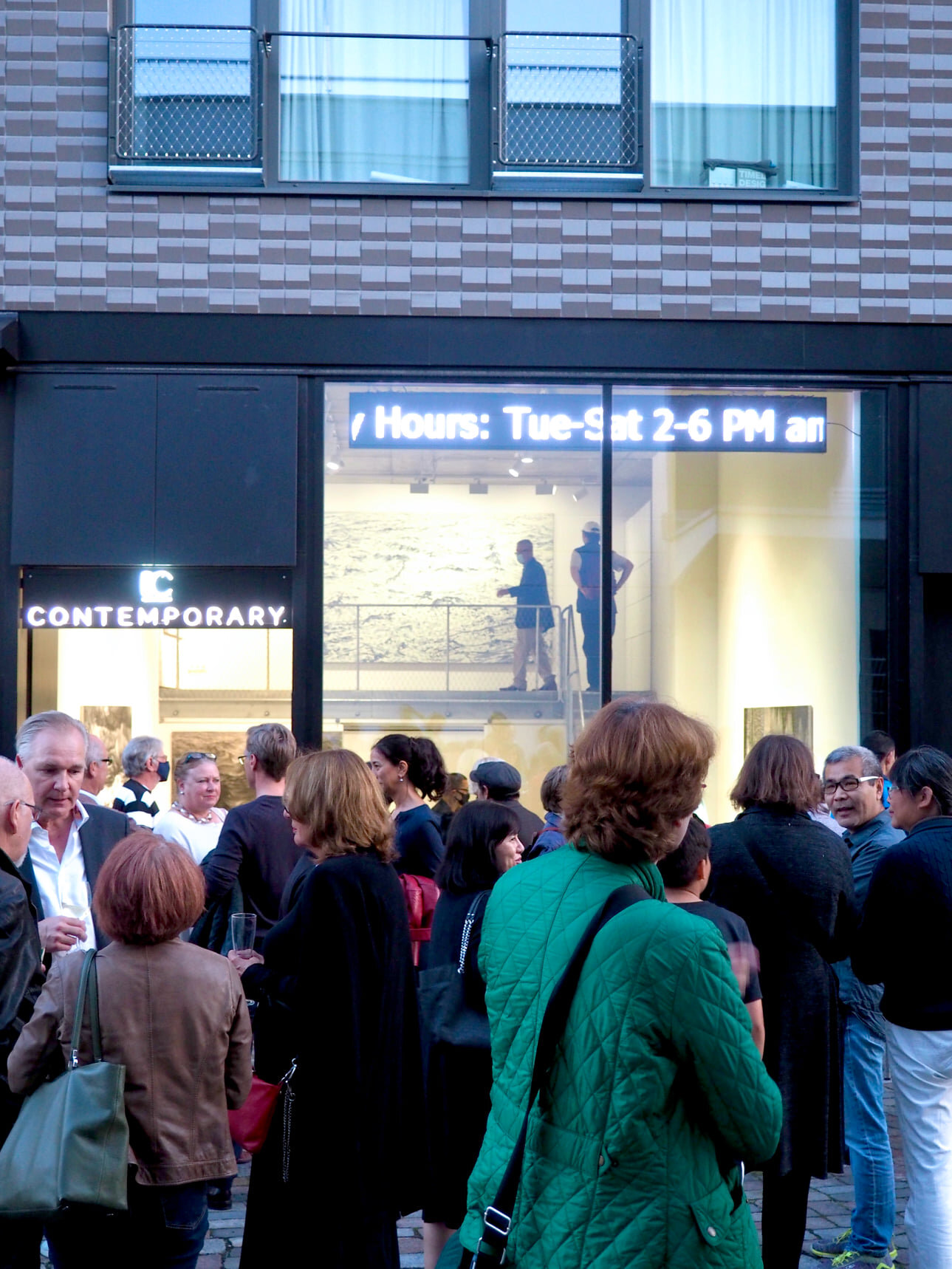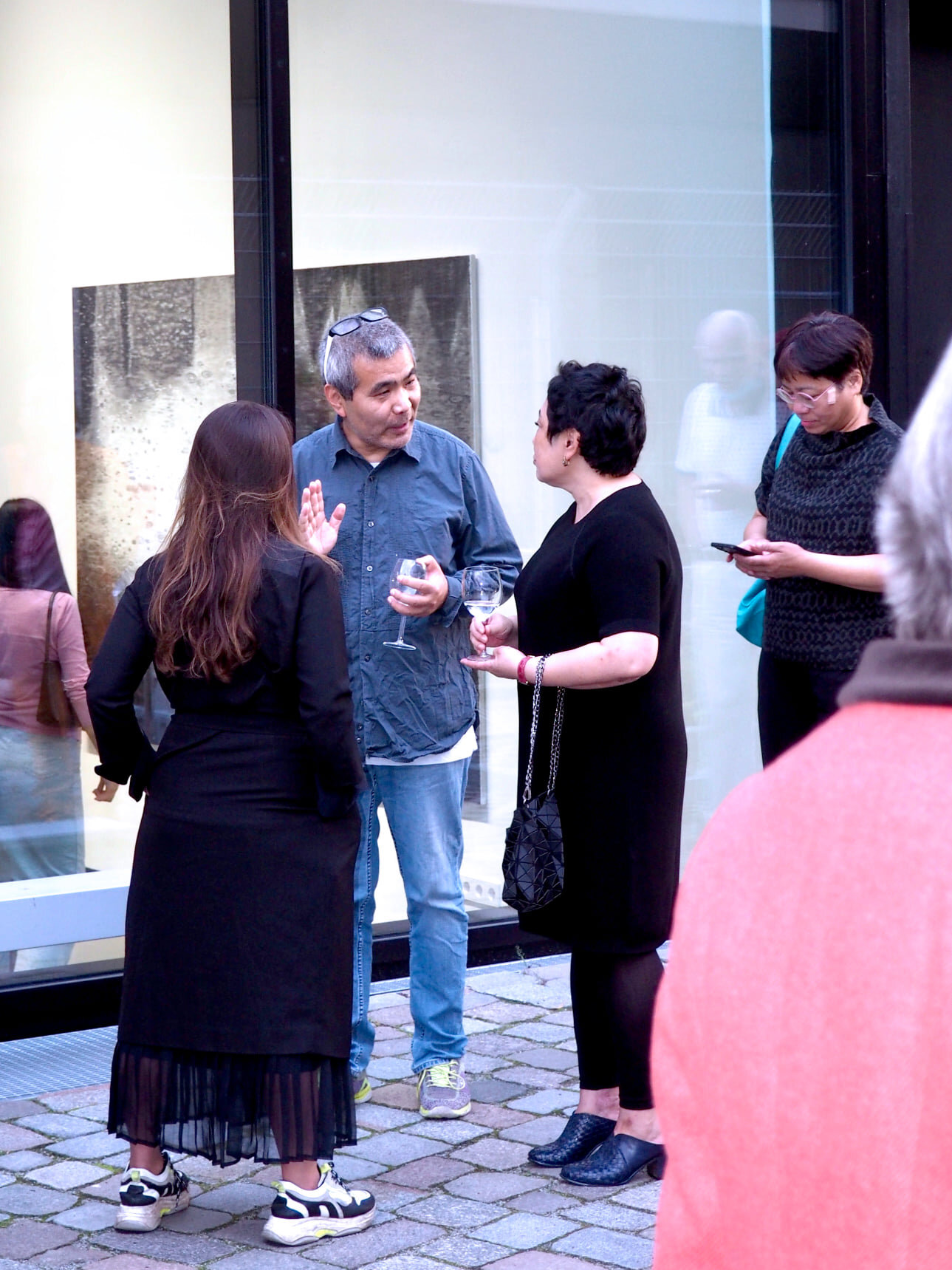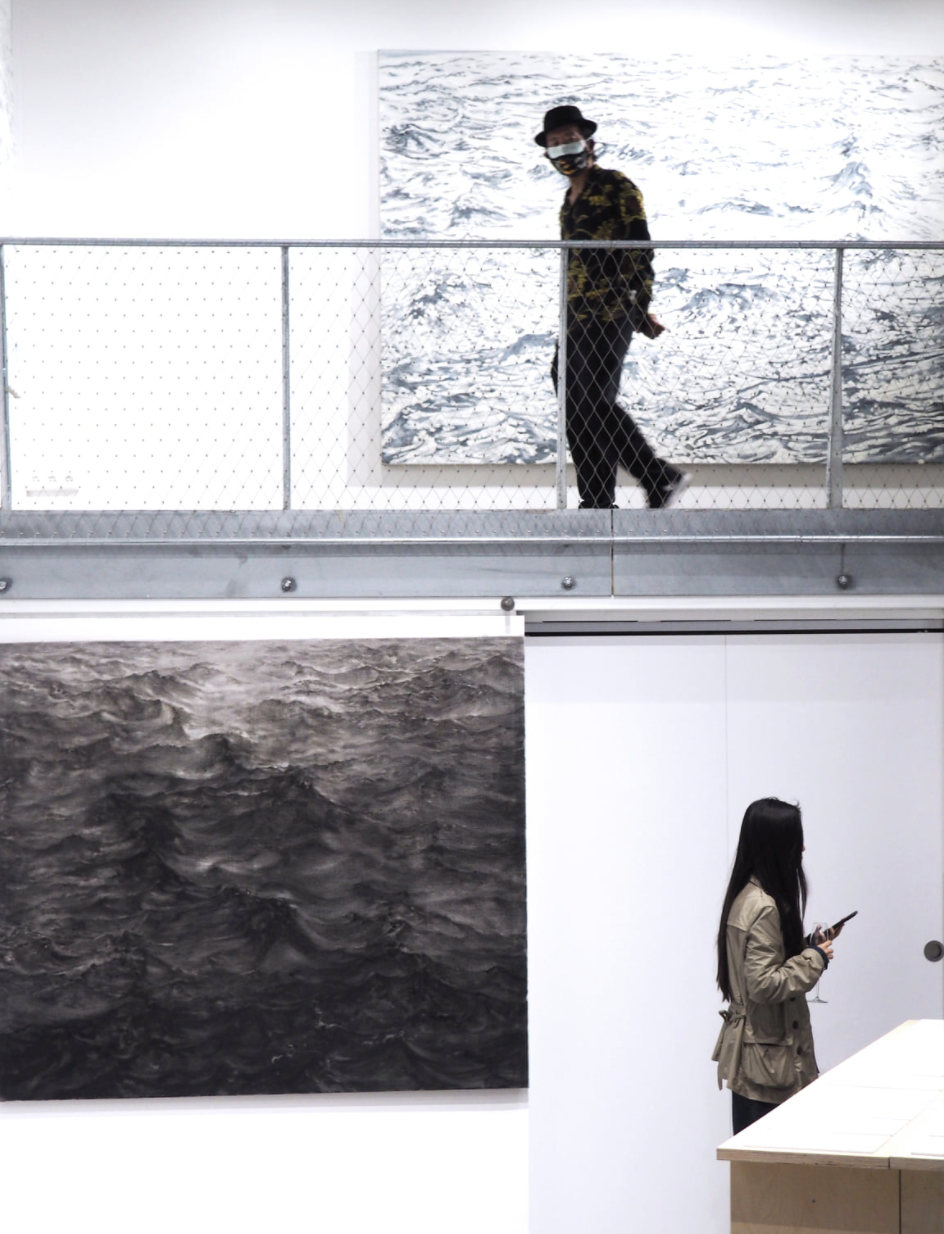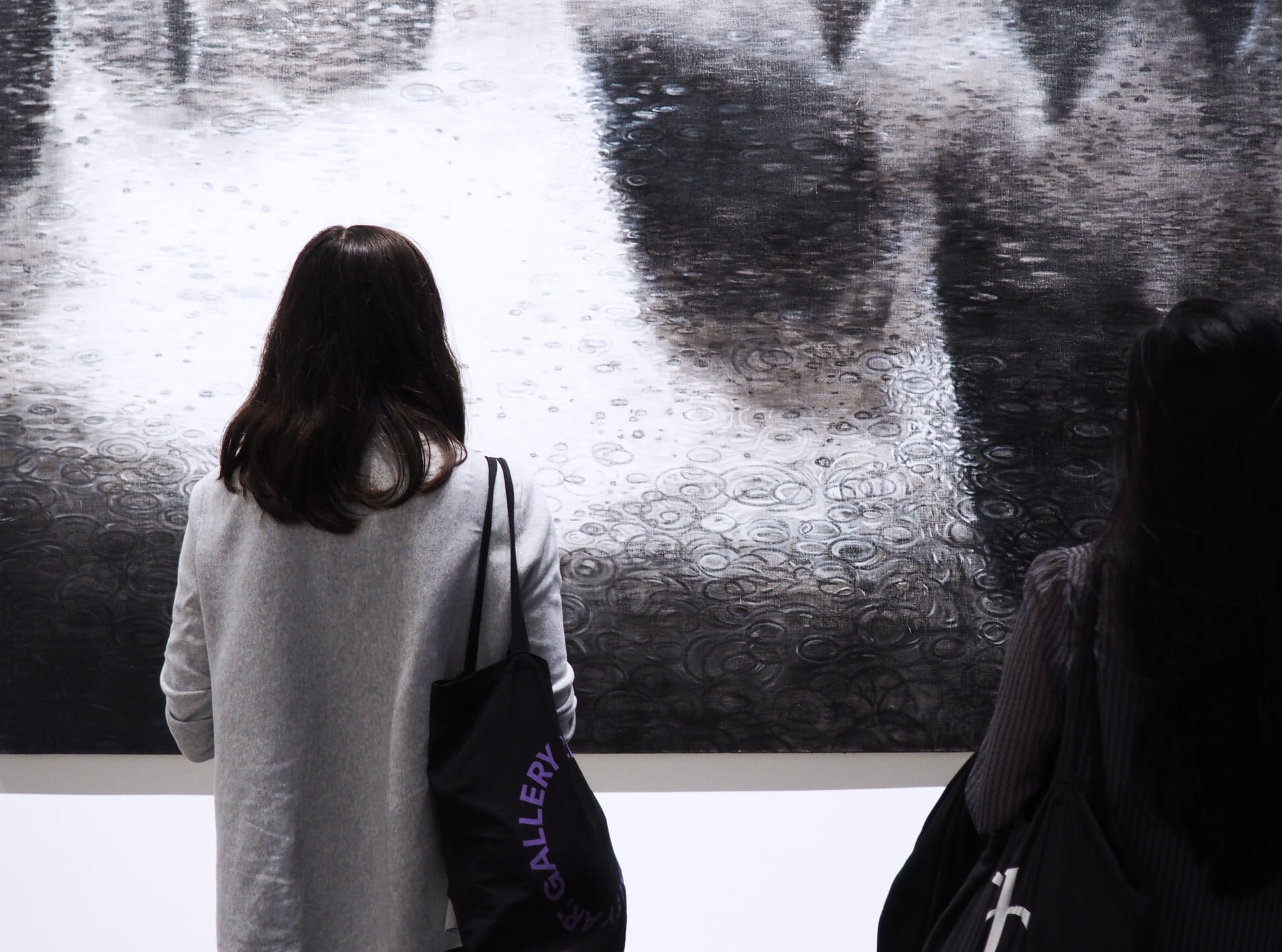meng huang
TIDE
exhibition duration
September 09 - November 07, 2020
exhibition view
Tide, 2020, Meng Huang, Kang Contemporary, Photo Florian Paninski
Tide, 2020, Meng Huang, Kang Contemporary, Photo Florian Paninski
Tide, 2020, Meng Huang, Kang Contemporary, Photo Florian Paninski
Please scroll down for German version
It is the German Romantic painters that deeply impress Meng Huang, and especially the work of Caspar David Friedrich such as The Monk by the Sea or the Abbey in the Oak Forest, both of which hang in the National Gallery in Berlin. Meng Huang has often gazed at them there – always viewing only one painting a day, and always for exactly 45 minutes. What fascinates the artist (who lives in Berlin and Beijing) about Friedrich's paintings is the kinship to Chinese landscape painting that he observes, especially to paintings of the Song Dynasty (960-1279 AD).
The three large-format, black and white oil paintings in Meng Huang's exhibition at KANG Contemporary depict scenes from nature that connect the paintings from the two epochs. Water-1 (2012) depicts lightly foaming waves on a moving water surface, which could also be seen as mountains. In Lake of Rain-1 (2020), raindrops draw circles on a still water surface; Nature-2 (2020) is a scene in which the water, shore, mountains and clouds are dramatically stratified in horizontal layers.
In all three pictures the painter takes the position of an observer, as if hovering in reverie over the surface of the picture. In particular with Nature-2, Meng Huang quotes, on one hand, the two-dimensional effect in the historical pictorial concept of Chinese painting, according to which the lower third of the canvas is the stage of human, earthly life, while the upper third depicts nature,
the heavenly. On the other hand, he succeeds thereby in allowing the motif to appear all the more three-dimensional – a clear reference to the example of paintings from the Romantic period.
If in these paintings – in contrast to many paintings of Caspar David Friedrich – there are no people to be seen, this is an apt and characteristic expression of isolation and loneliness, of atmospheres of longing. But above all, with these paintings Meng Huang concentrates upon the representation of natural phenomena as a traditional representation of the divine – appropriate to that vision of painting of the Song Dynasty, according to which the depiction of human beings is considered trivial.
That Meng Huang is known as a political artist – especially through his paintings in which people are depicted – places his works shown here at KANG Contemporary in a special light. Although each painting works independently, together they deliver, in their emptiness of human presence, a worthy framework for the artist’s sculptural work of 2018: Name.
For this work, central in his exhibition at KANG Contemporary, the artist has presented the names of all those persons who, in connection with the occupation of Tibet by the People's Republic of China, have burned themselves (self-immolated) since 2009: their names are written in Braille on fired porcelain plaques, one plaque for each name. These names are not allowed to be officially recognized or compiled in the People's Republic of China. Meng Huang chose the material for the white plaques, which are identical in size and shape, not only because the fired material references the cause of death of the people he names, symbolizing them in an urgent, haunting way through a kind of silent protest, but also because of the English term for porcelain: China. Of the total 162 plaques of this so eminently political as well as formally impressive work of Meng Huang, 30 plaques are being presented at KANG Contemporary.
Text Martin Conrads
English edit Carolyn Prescott
German version
Es sind die Gemälde der deutschen Romantik – und insbesondere die Caspar David Friedrichs –, die Meng Huang tief beeindrucken: „Der Mönch am Meer“ oder die „Abtei im Eichwald“ – beide in der Berliner Neuen Nationalgalerie hängend. Oft hat Meng Huang sie dort betrachtet – immer nur ein Gemälde am Tag, und immer für exakt 45 Minuten. Was den in Berlin und Peking lebenden Meng Huang an Friedrichs Bildern fasziniert, ist die von ihm bemerkte Verwandtschaft zu chinesischer Landschaftsmalerei, vor allem zu jener aus der Zeit der Song-Dynastie (960–1279 n. u. Z.).
Die drei großformatigen, schwarz-weiß gehaltenen Ölgemälde in Meng Huangs Ausstellung bei KANG Contemporary zeigen Naturszenen, die die beiden Malereiepochen verbinden: leicht schäumende Wellen auf einer bewegten Wasseroberfläche, die auch Berge sein könnten („Water–1“, 2012), Regentropfen, die auf einem stillen Gewässer ihre Kreise ziehen („Lake of Rain–1“, 2020) sowie eine Szenerie, bei der Wasser, ein Ufer, Berge und Wolken in horizontaler Staffelung dramatisch geschichtet sind („Nature–2“, 2020).
In allen drei Bildern nimmt der Maler die Position eines sich über der Oberfläche befindenden, schwebenden, entrückten Beobachters ein. Insbesondere bei „Nature–2“ zitiert Meng Huang so einerseits jene historische Bildvorstellung zweidimensional wirkender chinesischer Malerei, nach der im unteren Drittel der Leinwand die Bühne des menschlichen, irdischen Lebens gezeigt wird, während auf den oberen Dritteln die Natur, das Himmlische abgebildet ist. Andererseits gelingt es ihm auf diese Weise, das Motiv umso dreidimensionaler erscheinen zu lassen – ein deutlicher Verweis auf Bildbeispiele aus der Romantik.
Wenn auf diesen Gemälden – ganz im Gegensatz zu vielen Bildern Caspar David Friedrichs – keine Menschen zu sehen sind, so ist dies durchaus ein eigener Ausdruck von Isolation und Einsamkeit, von Atmosphären der Sehnsucht. Vor allem aber sucht Meng Huang mit diesen Gemälden die Konzentration auf die Darstellung von Naturerscheinungen als traditioneller Repräsentation des Göttlichen – gemäß jener Vorstellung der Malerei der Song-Dynastie, nach der die Abbildung von Menschen als trivial gewertet wird.
Dass Meng Huang insbesondere durch seine Gemälde, auf denen Menschen abgebildet sind, als auch politischer Künstler bekannt ist, lässt seine bei KANG Contemporary gezeigten Bilder in besonderem Licht erscheinen: So eigenständig jedes von ihnen ist, liefern sie in ihrer Menschenleere einen würdigen gemeinsamen Rahmen für Meng Huangs skulpturale Arbeit „Name“ von 2018.
Für dieses bei KANG Contemporary zentral gezeigte Werk hat der Künstler alle Namen jener Personen, die sich im Zusammenhang mit der Besetzung Tibets durch die Volksrepublik China seit 2009 selbst verbrannt haben, in Braille-Schrift auf Porzellantafeln gebrannt – für jeden Namen eine Tafel. Es handelt sich um Namen, die in der Volksrepublik offiziell nicht genannt, nicht gesammelt werden dürfen. Das Material für die weißen größen- und formidentischen Tafeln wählte Meng Huang nicht nur, da der gebrannte Werkstoff Beistand leistet, die Todesursache der von ihm im Sinn eines stillen Protests benannten Personen in eindringlicher Weise zu symbolisieren, sondern auch wegen des englischen Begriffs für Porzellan: „China“. Von den insgesamt 162 Tafeln dieser so eminent politischen wie formal eindrücklichen Arbeit Meng Huangs werden bei KANG Contemporary stellvertretend 30 gezeigt.
Text Martin Conrads
ARTWORK
《Water-1》, 2012, Meng Huang, oil on canvas, 180 x 280 cm, Kang Contemporary
Meng Huang, 《Lake Of Rain-1》, 2020, oil on canvas, 180 x 280 cm, Kang Contemporary
Meng Huang,《Nature-2》, 2020, oil on canvas, 180 x 280 cm, Kang Contemporary
Meng Huang,《Landscape-7》, 2018, oil on canvas, 155 x 180 cm, Kang Contemporary
Meng Huang,《Landscape-2》, 2018, oil on canvas, 155 x 180 cm, Kang Contemporary
Meng Huang,《Name-47》, 2018, Porcelain, 30.5 x 21.5 cm, Kang Contemporary
Meng Huang,《Name-58》, 2018, Porcelain, 30.5 x 21.5 cm, Kang Contemporary
VERNISSAGE
september 09, 2020 AT 7 PM
Tide, 2020, Meng Huang, Kang Contemporary, Vernissage, Photo Florian Paninski














